When it comes to choosing the perfect pair of running shoes, the decision can be overwhelming.
In the realm of running footwear, two brands that often stand out are HOKA and ASICS.
Both have earned their stripes in the running community, each with its unique strengths and features.
In this detailed comparison, we will explore the nuances of HOKA vs. ASICS running shoes, helping you make an informed choice tailored to your specific needs.
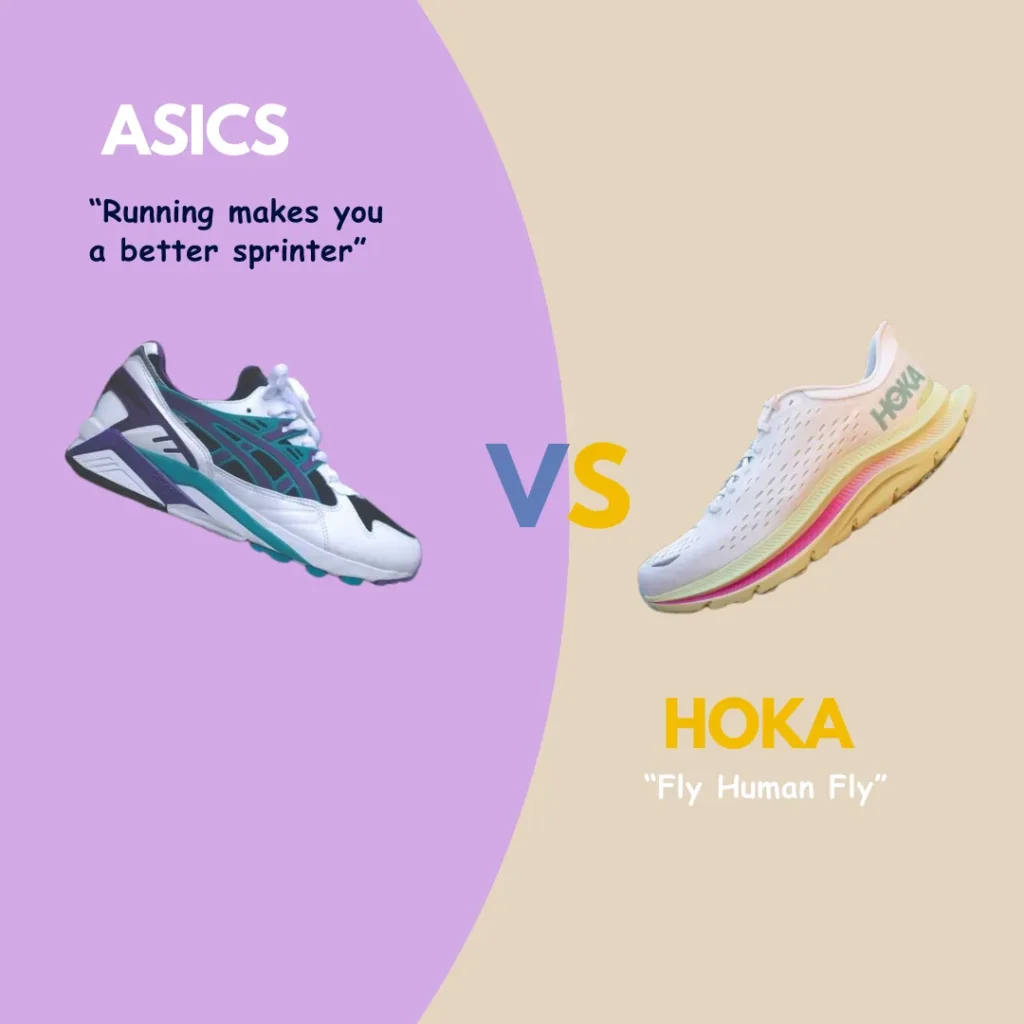
Which Is Better, HOKA Or ASICS Running Shoes?
Before delving into the intricacies, let’s address the fundamental question: Which brand is superior, HOKA or ASICS?
The answer isn’t one-size-fits-all; it depends on your individual preferences, training goals, and running style.
Also Read – The Ultimate Guide to HOKA vs Brooks Running Shoes Comparison
HOKA Running Shoes
Innovation and Design
HOKA made a remarkable entrance into the running shoe market with its groundbreaking design philosophy.
They are renowned for their maximalist cushioning, providing runners with an exceptionally plush and comfortable experience.
This approach caters to those seeking ample cushioning for a luxurious ride.
HOKA’s cushioning is lightweight and relies on PROFLY technology and molded EVA foam for its marshmallow-like softness.
You May Also Like – Brooks vs Asics: The 7 Key Differences Between Brands
Target Audience
Initially designed for trail runners and ultramarathon enthusiasts, HOKA shoes offer maximal cushioning and a stable platform for tackling long miles on uneven terrain.
Over time, HOKA has gained popularity among masters runners seeking enhanced cushioning for joint comfort and everyday runners who appreciate the wider base of support and higher stack height.
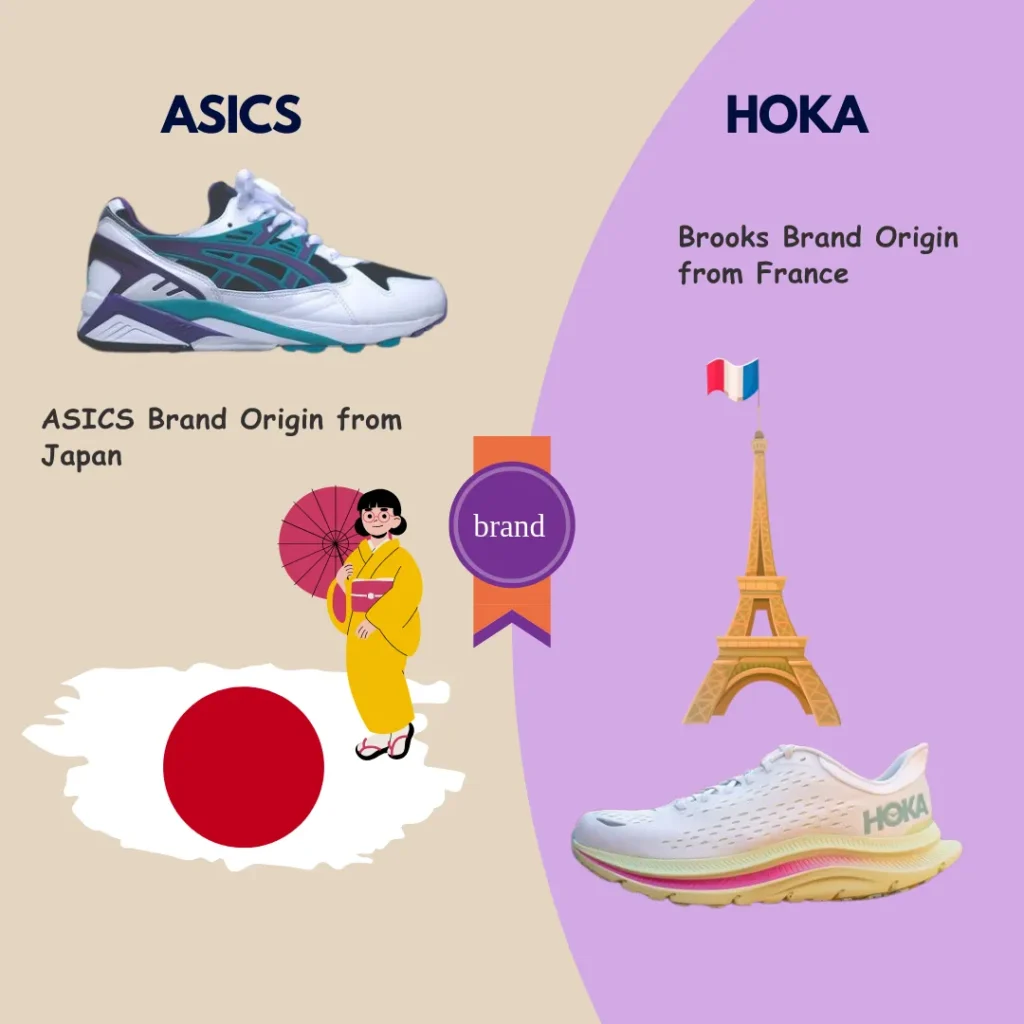
ASICS Running Shoes
Cushioning Technology
ASICS, on the other hand, is known for its GEL Technology, featured in many of their running shoes.
This technology offers plasma-like cushioning, which effectively disperses impact forces and reduces shock.
ASICS also incorporates Flytefoam technology for lightweight cushioning, enhancing energy return and responsiveness compared to traditional EVA foam.
Also Read – Asics vs Nike: Which Brand is Right for You?
Target Audience
ASICS running shoes cater to a diverse range of runners looking for various options in stability and cushioning.
They are favored by runners who appreciate the benefits of GEL Technology and those seeking a more traditional running shoe experience.
HOKA Vs ASICS: Main Differences
Now, let’s dissect the main distinctions between HOKA and ASICS running shoes across different dimensions:
Cushioning
The primary contrast between HOKA and ASICS running shoes lies in their cushioning technology and the resulting feel.
HOKA embraces maximalist cushioning across its models, boasting a thick midsole for ultimate plushness.
The cushioning is remarkably lightweight, thanks to the incorporation of PROFLY technology and molded EVA foam.
ASICS employs plasma-like GEL and Flytefoam technology for cushioning.
The GEL enhances shock absorption, while Flytefoam provides improved energy return and responsiveness compared to traditional EVA foam.
Read Also – ASICS Gel Contend 8 vs Gel Kayano 30: A Comprehensive Comparison
Stability
Both HOKA and ASICS running shoes are not typically designed for severe overpronation control. However, they do differ in their approaches to stability:
ASICS Stability
ASICS running shoes offer stability through an external heel clutch, aiding in controlling pronation at landing.
Additionally, they feature a Duomax midsole, a dual-density material that provides lateral support and prevents excessive pronation and arch collapse.
HOKA Stability
HOKA running shoes prioritize stability by design.
Their wide base acts as a stabilizing factor, keeping your foot secure upon landing.
Some HOKA models incorporate features like J-Frame technology for lateral stability and firmer foam on the medial side to counter excessive pronation.
Durability
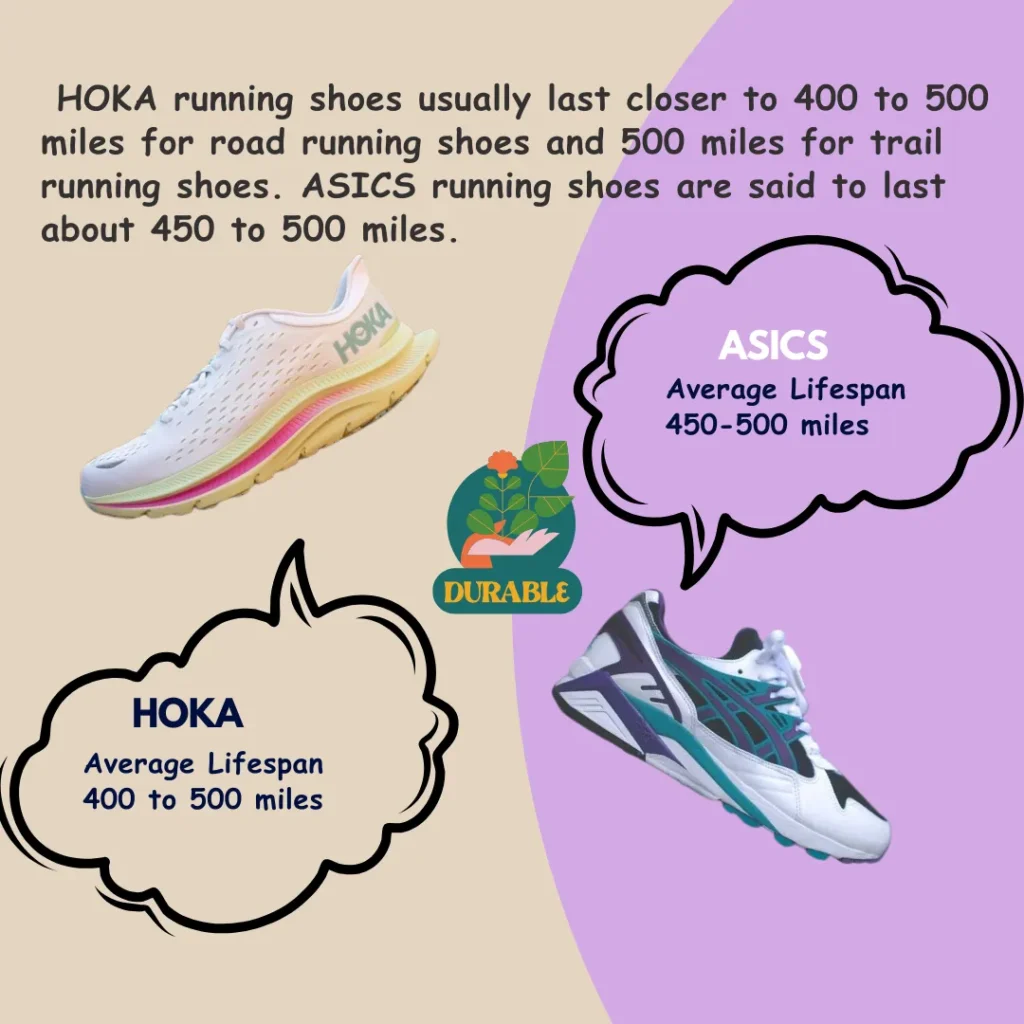
The durability of running shoes depends on various factors, including materials, construction quality, and personal factors such as body weight, gait, and running habits.
Both HOKA and ASICS running shoes are known for their durability, often outlasting competitors.
HOKA running shoes typically last around 400 to 500 miles for road running shoes and 500 miles for trail running shoes.
ASICS running shoes are estimated to endure approximately 450 to 500 miles.
This suggests that both brands offer extended longevity, allowing you to maximize your investment.
Fit and Feel
Both HOKA and ASICS running shoes are inclined toward a narrow fit compared to brands like Brooks and New Balance.
However, there is some variability in fit among different models:
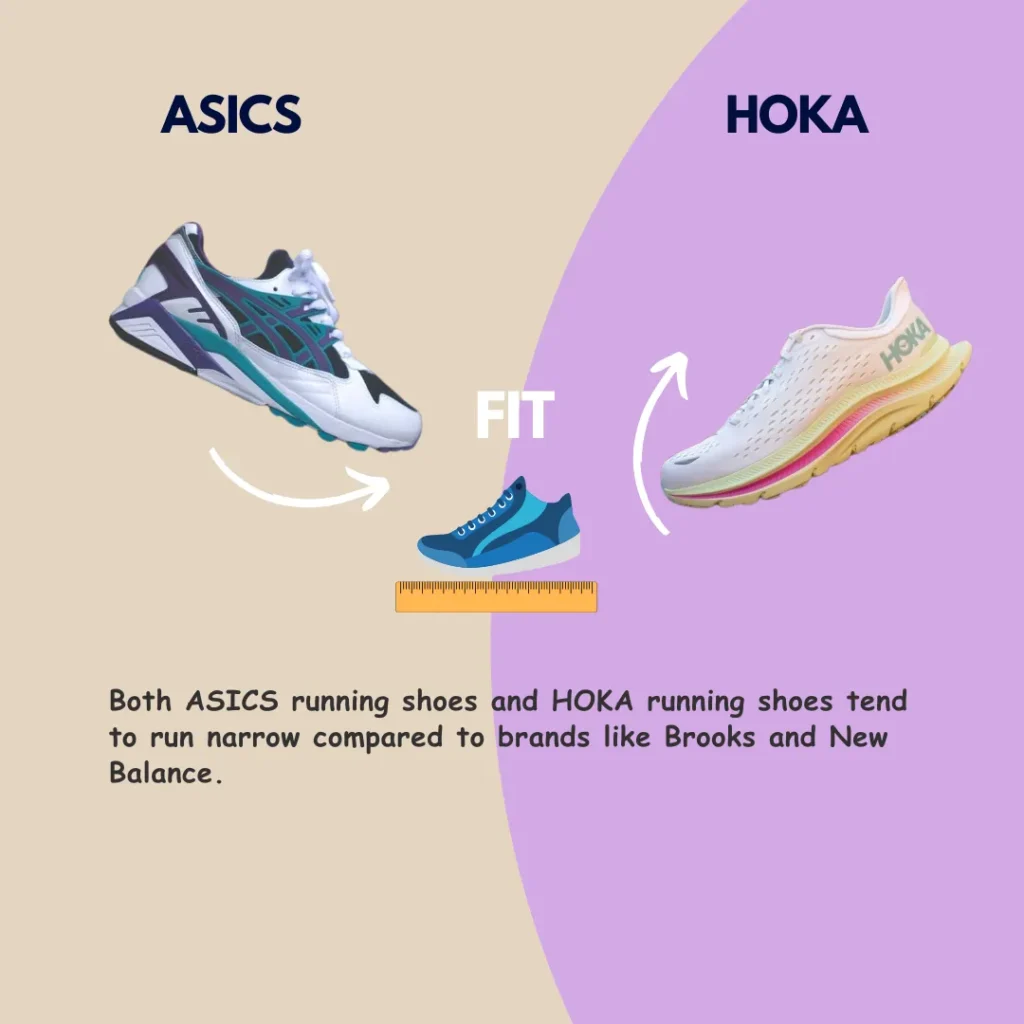
HOKA Fit
HOKA running shoes have historically featured a narrow fit, though recent models are transitioning to a slightly wider forefoot shape.
Standard-width HOKA shoes (B for women, D for men) tend to be snugger than size- and width-matched alternatives from other brands.
Also Read – Do Hokas Run Big or Small? Let Me Share My Personal Experience!
ASICS Fit
ASICS running shoes are also known for their narrow fit, particularly in the heel and midfoot areas.
Even the toe box is more tapered than squared off and wide. ASICS models provide a traditional feel even with cushioned versions.
Heel Drop
Another notable difference between HOKA and ASICS shoes is the heel drop, which refers to the height difference between the heel and toe of the shoe:
HOKA Heel Drop
HOKA running shoes typically feature a low heel-to-toe drop of approximately 6 to 8 millimeters. This design promotes a more natural foot strike and transition.
ASICS Heel Drop
In contrast, ASICS running shoes maintain a standard heel drop, usually ranging from 8 to 13 millimeters depending on the specific model.
This design caters to those who prefer a traditional running shoe feel.
Price
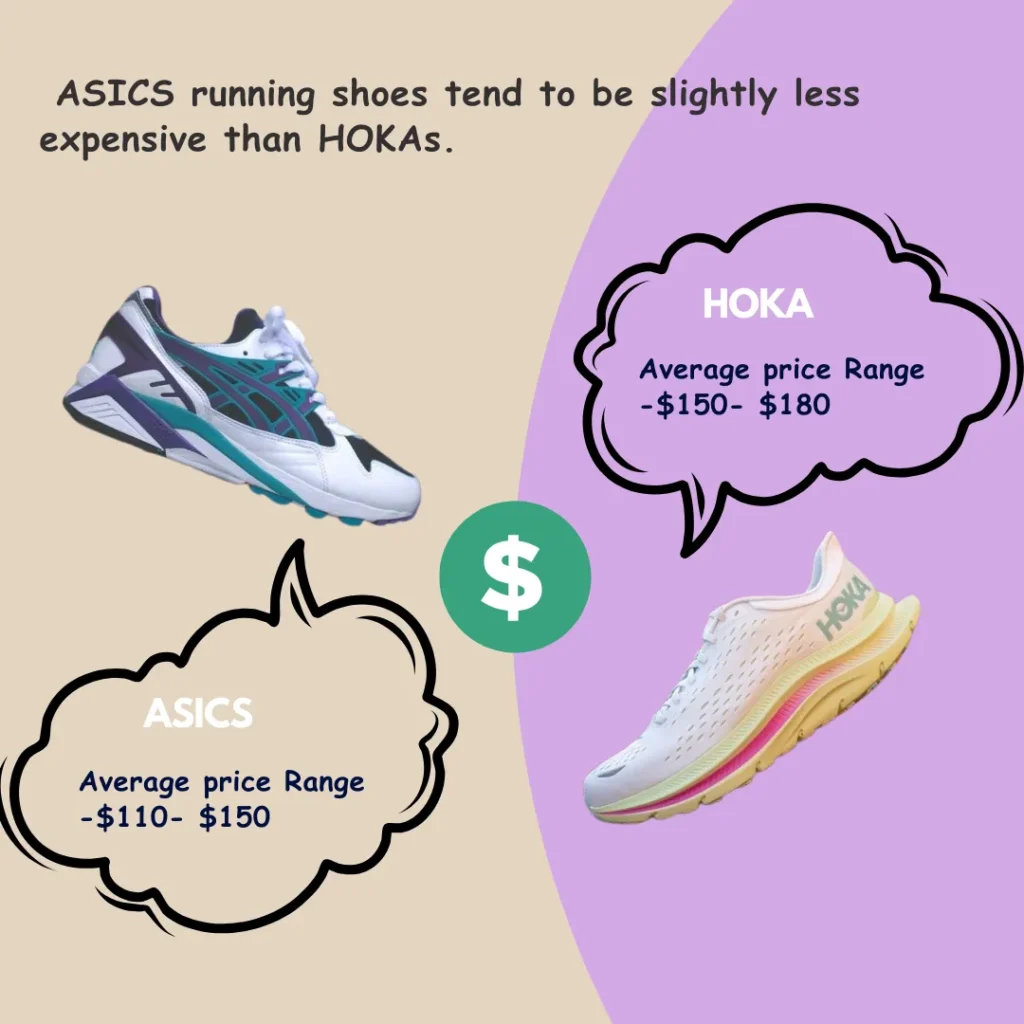
When it comes to pricing, both HOKA and ASICS offer competitive options for premium running shoes.
ASICS shoes tend to be slightly more affordable than HOKA, making them an attractive choice for budget-conscious runners.
The average price range for HOKA running shoes falls between $150 and $180, while ASICS shoes typically range from $110 to $160.
It’s essential to consider your budget alongside your specific preferences when making your selection.
Also Read – Why Are Hoka Shoes So Expensive: Unraveling the Expensive Appeal of Hoka Shoes
Conclusion
In conclusion, both HOKA and ASICS manufacture exceptional running shoes suitable for runners with diverse needs and preferences.
The choice between HOKA vs.
ASICS ultimately depends on your priorities, whether you prioritize maximal cushioning, stability, durability, fit, heel drop, or budget considerations.
Also Read – Hoka Speedgoat 5 vs Challenger 7: Unveiling the Ultimate Trail Running Showdown
FAQ
What are the primary differences between Hoka and Asics running shoes?
Hoka and Asics present distinctive features in their running shoe designs. Hoka emphasizes maximal cushioning and a unique midsole geometry that aids in shock absorption and stability. In contrast, Asics focuses on a balance between cushioning, support, and stability, often employing their Gel technology for cushioning and guidance systems for stability.
Which brand, Hoka or Asics, is better for long-distance running?
Both Hoka and Asics cater to long-distance running, but the choice often boils down to personal preference and specific foot characteristics. Hoka’s maximal cushioning and Meta-Rocker technology are favored by some long-distance runners for their ability to reduce fatigue. On the other hand, Asics offers durable midsoles and support systems that cater well to sustained running sessions, making them a reliable choice for many long-distance runners.
How do Hoka and Asics differ in terms of stability and support?
Hoka shoes tend to emphasize cushioning and a smooth ride, whereas Asics incorporates stability features such as medial posting and guidance systems in many of their models. Asics often uses DuoMax or Trusstic systems to enhance midfoot support and reduce pronation, catering to individuals seeking added stability during runs.
Which brand, Hoka or Asics, is more suitable for trail running?
Both Hoka and Asics offer trail running shoe options, each with its unique strengths. Hoka’s trail shoes often feature an oversized midsole for enhanced cushioning and a stable ride, which can be beneficial on rugged terrain. Asics trail running shoes are designed with durable outsoles and protective elements, providing good traction and stability on various surfaces encountered during trail runs.
Are there any standout features that distinguish Hoka and Asics in terms of design and technology?
Certainly, Hoka’s maximal cushioning and Meta-Rocker technology are distinctive, promoting a rolling effect from heel to toe and reducing the impact on joints. Asics, on the other hand, is recognized for its Gel cushioning technology, which offers excellent shock absorption. Additionally, Asics incorporates various support systems like the Guidance Line and Trusstic System for stability and efficient gait transition.
